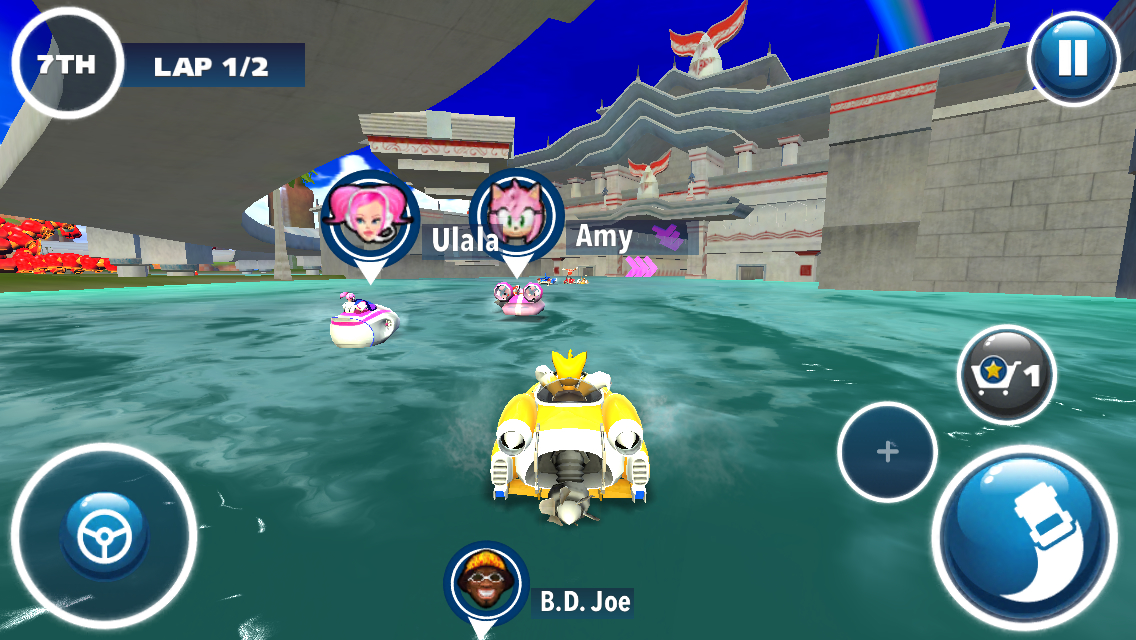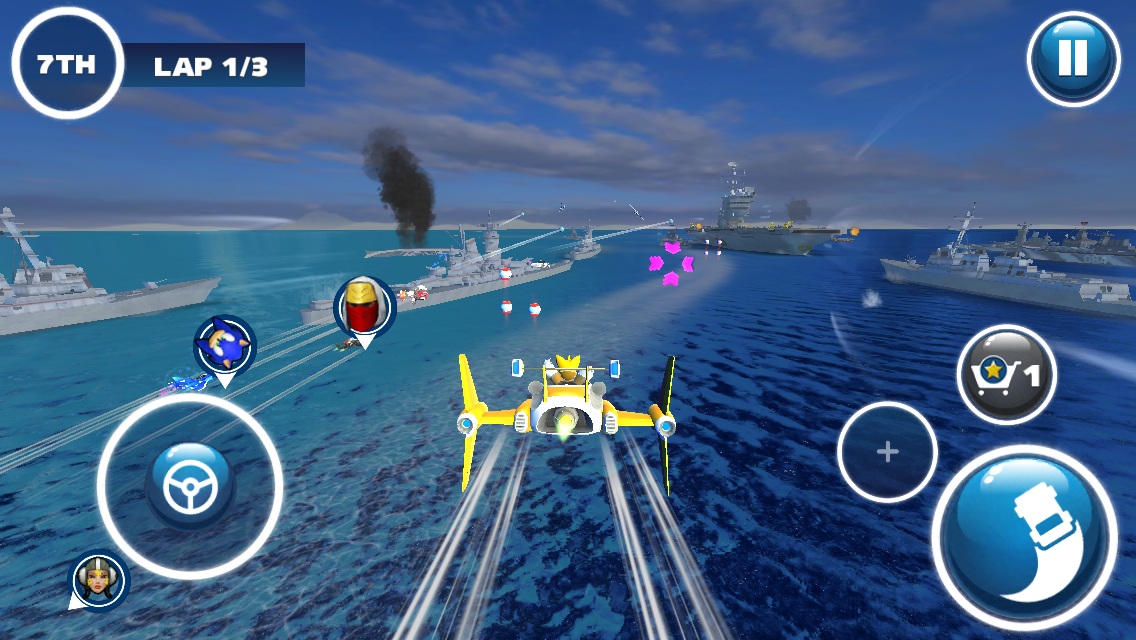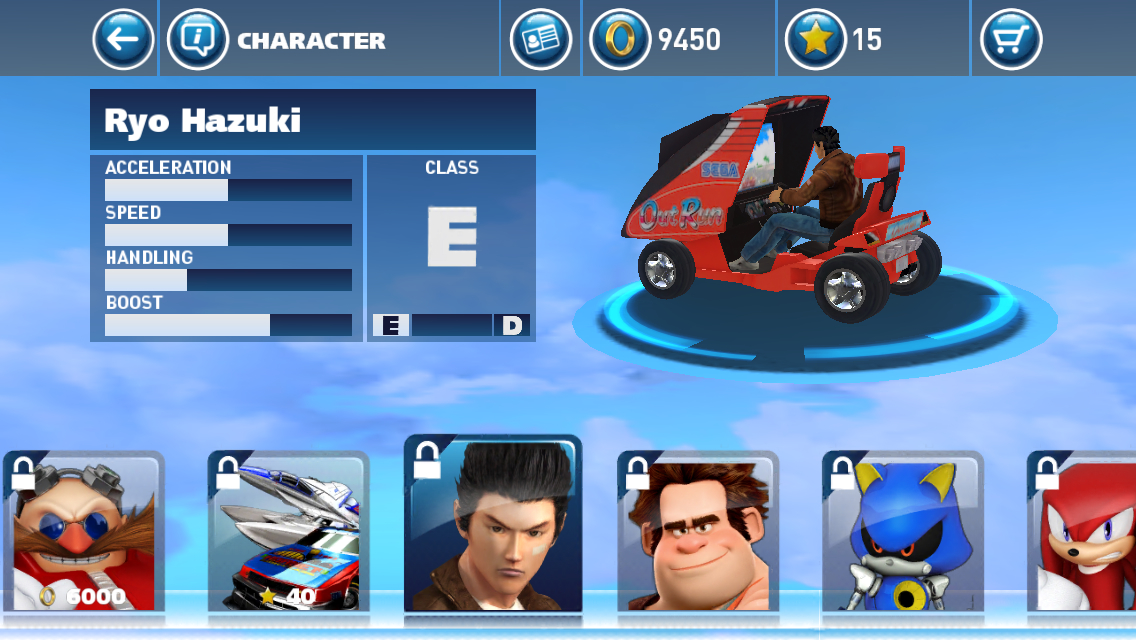![]() It seems to be an unwritten rule that every major character gets their own racing game, and Sonic the Hedgehog is obviously major enough to have had a few in his history. The racing genre is a pretty good fit for the speedy character, so it’s not surprising that we’ve seen a number of takes on the concept. The Game Gear Sonic Drift games were pretty mediocre kart racers that had Sonic and his pals shoehorned into SEGA’s pre-existing Power Drift series. The games begged the question of why Sonic would use a car, and SEGA replied in kind with Sonic R, a game that had Sonic and company racing on foot to some of the greatest music ever to grace a racing game. Unfortunately, the game was pretty bad, so Sonic hung up his racing stripes for a while until the Sonic Riders series came about, which focused on hoverboard racing. It was popular enough to spawn a couple of sequels, but still didn’t quite scratch the itch properly.
It seems to be an unwritten rule that every major character gets their own racing game, and Sonic the Hedgehog is obviously major enough to have had a few in his history. The racing genre is a pretty good fit for the speedy character, so it’s not surprising that we’ve seen a number of takes on the concept. The Game Gear Sonic Drift games were pretty mediocre kart racers that had Sonic and his pals shoehorned into SEGA’s pre-existing Power Drift series. The games begged the question of why Sonic would use a car, and SEGA replied in kind with Sonic R, a game that had Sonic and company racing on foot to some of the greatest music ever to grace a racing game. Unfortunately, the game was pretty bad, so Sonic hung up his racing stripes for a while until the Sonic Riders series came about, which focused on hoverboard racing. It was popular enough to spawn a couple of sequels, but still didn’t quite scratch the itch properly.
The most notable thing about the sequel, Sonic Riders: Zero Gravity was that in addition to the regular cast of Sonic characters, stars from some of Sonic Team’s other games made an appearance. Amigo from Samba de Amigo, Billy Hatcher from Billy Hatcher & The Giant Egg, and NiGHTS from NiGHTS Into Dreams were all playable, something that thrilled SEGA fans even though the game itself didn’t. I can’t say whether or not this was the seed of the next attempt, but it’s safe to say that people who were excited about a few SEGA characters making their way into a Sonic racing game were beside themselves with joy at SEGA’s 2010 release of Sonic & SEGA All-Stars Racing ($3.99). It wasn’t just a great piece of fanservice, though it was that in spades, it was also an excellent racing game in its own right. With a roster representing 14 different SEGA franchises, tons of great unlockables via an incredibly well-fleshed out single player mode, and gameplay that played like a beautiful mash-up of Outrun 2 and Mario Kart, it wasn’t just the best Sonic racing game to date, it was one of the best character racing games of all-time.
Developers Sumo Digital didn’t just knock it out of the park with the home console and PC versions, though. They also created a Nintendo DS version with the roster almost completely intact and modified versions of every track, running at a better framerate than the console versions. It’s this version that was the basis for the iOS port that came the following year, albeit with a significantly reduced roster and track list. Although quite a bit lighter in terms of content, it was still a great racing game with a very reasonable price. Later on, it went free and altered the prices of unlockables in its shop a bit to push people towards buying SEGA Miles via IAP, which was kind of lame for people who had bought it at full price, but the game itself was still great to play.

A follow-up was released in 2012, called Sonic & All-Stars Racing Transformed (Free), and once again, iOS gamers have had to wait just over a year for their version. Again, it’s lighter in terms of content compared to the other versions, but what’s here is still enough to make it the best kart racer available on iOS. The drift-heavy gameplay of the first game carries over here, but true to the title, there’s a whole lot of transforming going on. Front and center is that your vehicle will transform from kart to boat to plane as the track calls for it, sometimes all during the course of one race. Mario Kart 7 on the Nintendo 3DS did this before this game, but it was more of a simple gimmick in that game, while in All-Stars Transformed, each vehicle type handles a bit differently and enjoys a fair amount of time in the spotlight.
The other transforming element of the console games were the tracks themselves, which would often change completely from lap-to-lap as things were destroyed or paths opened up in front of you. The iOS version keeps this aspect intact, though the destruction of some of the levels is toned down a bit visually. The deepest cuts to the game are in the roster. A mere 14 of the total 33 characters available in other versions have made it here, though surprisingly given he hasn’t even made it to the console versions yet, Ryo Hazuki from Shenmue is one of them. Seeing Wreck-It-Ralph taking up a spot on such a limited roster in favor of characters like NiGHTS, Alex Kidd, Vyse, and Gilius Thunderhead is kind of disappointing, but I guess kids don’t really know or care who they are while Ralph is likely known to all. Going by the last version, there will probably be a few more characters added via updates later, so I guess I can keep my fingers crossed for my favorite would-be Saturn mascot to turn up.
In all, the roster includes Sonic, Tails, Amy, Knuckles, Dr. Eggman, Metal Sonic, and Shadow from the Sonic the Hedgehog games, Amigo from Samba de Amigo, Gum from Jet Set Radio ($2.99), B.D. Joe from Crazy Taxi (Free), Joe Musashi from Shinobi, Ulala from Space Channel 5, Ryo Hazuki from Shenmue, Ralph from Disney’s Wreck-It-Ralph, and AGES, the amazing secret character from the other versions. It’s a decent mix, apart from giving a complete snub to the Saturn. Like in the first game, though, you are not simply given these characters. You have to unlock them, and this is where things might get uncomfortable for some of you.

Buying the game automatically gives you the VIP pack, which unlocks four characters, as well as the Grand Prix mode and the Multiplayer mode. This, by the way, is why the game prompts you for your iTunes account when you start it up the first time. All of the other characters can be unlocked by playing through the game’s World Tour mode, which sets a massive variety of challenges in front of you across the game’s 13 tracks. By completing certain events, you unlock the ability to purchase the characters using rings, which are earned as you play. The price tags on the characters are very reasonable compared to the last game, with the sole exception of AGES, who requires you to collect a decent amount of the game’s premium currency. Even AGES isn’t priced all that high, though. You should get more than enough to unlock it by playing through World Tour. It’s a lot easier to unlock AGES here than in the console versions.
If that all sounds like too much work for you, you can pay to unlock the characters right from the start. The IAP for this is a bit pricey in my opinion, but since you can earn everything by playing the game, not grinding mind you, but simply playing through, I’m not going to get too upset about this option. If I’m to be really honest, if I could have just paid to unlock everything in the PlayStation 3 version, I’d probably have done it already, because I’ve been playing it for a year and I still have characters I can’t unlock. The other IAP in the game allows you to race for free on all tracks, which I probably need to explain a bit more.
Each of the races in the game is available to play on four different difficulty settings. Only one of these is free to play, while the others cost rings or premium currency to enter. As you progress through the game, the difficulty level of the free race gets progressively harder. The pay-off from winning the events is always higher than the cost of entry, so if push comes to shove, you can always pay to enter the easy difficulty for an event and have a really high chance of making your entry fee back and then some. If you happen to run so low on rings that you can’t enter the easy race for the current level, you can always go back and earn some by running a couple of free races. It’s not something I ever had to do, but the option is there. Playing on the highest difficulty requires a fairly small amount of the premium currency, so I’m less enthused about that, but again, the reward if you win is worth more than the ante. If you buy that IAP I mentioned in the last paragraph, none of this matters. You can do any race you like without having to pay an ante. It’s another expensive IAP, and I don’t feel it’s even remotely necessary to get the full experience, but if you’ve got money and anxiety, it’s there for you.

Anyway, that’s the IAP situation. It’s not hard to envision a future where the game goes free and no longer includes the VIP pass, but that’s six of one, half dozen of the other since the VIP pass cost is the same as the current price of the App. It’s a bit offputting initially, but I ran the game through the ringer and didn’t need to buy IAP or grind at any point, so I’m not personally too rustled about it. I’m a bit more annoyed at needing to hook up my Facebook for leaderboards, but Game Center apparently isn’t up to snuff on its own for what Sumo Digital wanted to do with this game.
Back to the game itself, All-Stars Transformed gives you two single player modes, World Tour and Grand Prix. World Tour sends you all around the different tracks, with specific challenges including placing first, taking out all of your opponents, drifting your way through checkpoints, maintaining a boost, and more. This is kind of the main mode, since you have to play through it to unlock additional Grand Prix cups beyond the first one. You’ll also unlock characters in this mode at regular intervals. Some of the challenges are pretty difficult, especially if you aren’t used to this game’s playstyle, but the easy version of each of the challenges shouldn’t prove too taxing for anyone. There are tons of events to clear in this mode, giving you a good bit to chew on.
The other single player mode is Grand Prix, where you must complete three races to determine the overall winner. This mode, too, offers unlockable content in the form of upgrades. Each character’s vehicle can be upgraded in different categories using the rings you’ve collected. These upgrades give you a big advantage not only in Grand Prix mode but in completing the challenges in World Tour mode as well. Ideally, you’ll want to be bouncing between these two modes to keep making smooth progress. Your upgrades can’t be used in multiplayer, for the sake of fair play, I’d imagine.

Also technically counting as single player content are the weekly and daily missions, which give you challenges on certain courses using certain characters. It’s a nice way to try out some of the other characters before you’ve unlocked them, and there are nice rewards for clearing them. These get more difficult with each successive clear, but the rewards also increase in step. With all of this single player content, the most interesting omission is a simple quick race mode. There’s no way to just choose a track and character and have a full race, which is something of a basic thing to leave out.
On the multiplayer side of things, the great local multiplayer from the first game makes a return, and brings his scary friend Mr. Online Play with him. Up to four players can battle to be the champion in five different leagues. Multiplayer is handled through Game Center, and while I had some trouble actually filling out a full four players thanks to my unusual time zone, the races themselves went smoothly and mostly lag-free. Many recent racers have promised online play, but this one delivers it, and does it well. Sumo Digital did an excellent job here.
The tracks in this game are awesome. The first game only tapped a few different SEGA franchises, and none outside of the realms of the playable characters, but Transformed isn’t shy about its love for all things SEGA. An Afterburner-inspired track will have you soaring through the air and seas before setting wheels down on the deck of an aircraft carrier, while a Panzer Dragoon track in its third lap sees the track destroyed by a dragon taking off, leading to an impromptu switch to airplane mode. There are different paths to take in each track, with some shortcuts to find in a few of them, and they’re top-to-bottom filled with SEGA goodness.
The controls work a bit better here than they did last time, in my opinion. You once again have your choice of virtual controls or tilt, and both of them work very well. The virtual controls include a stick for movement, a button for drifting and stunts, a button to use weapons you pick up, and another button for using an all-star move anytime you want in single-player mode, which costs one unit of premium currency, so you shouldn’t ever press that button. Drifting is simple and intuitive, as it should be, and the stick is at the perfect level of sensitivity. Directing your attacks is as simple as swiping up or down on the weapon button, a very intuitive way of handling that particular action. The game also supports MFi controllers, if you happen to have one.
This all adds up to a sequel that exceeds the original in every possible way. While I was initially worried about the IAP in Sonic & All-Stars Racing Transformed, I was really pleased to find the whole game was accessible without dipping into it or grinding. I wish more of the All-Stars were in this version of the game, but for the price, I really can’t gripe about the amount of content here, especially since almost all of the tracks are here. It’s considerably closer to the console version than the last one was. All in all, this is the best kart racer available on iOS, a worthy port, and just a great game all around.